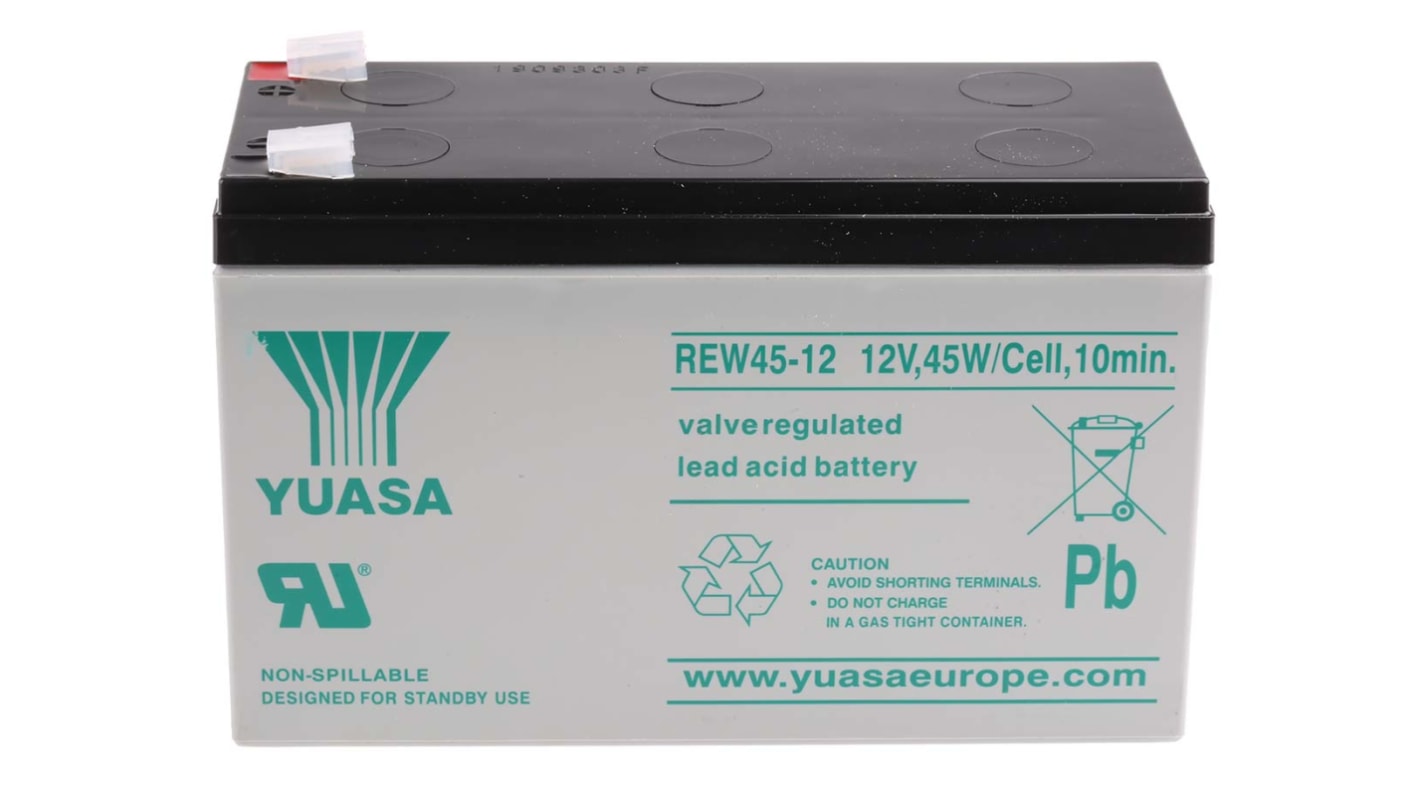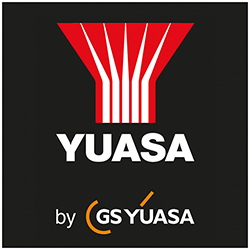Yuasa 12V Faston 6.35mm Sealed Lead Acid Battery, 7.3Ah
- RS Stock No.:
- 613-0854
- Mfr. Part No.:
- REW45-12
- Brand:
- Yuasa

Subtotal (1 unit)*
£62.09
(exc. VAT)
£74.51
(inc. VAT)
FREE delivery for orders over £50.00
In Stock
- 143 unit(s) ready to ship
- Plus 72 unit(s) ready to ship from another location
Need more? Click ‘Check delivery dates’ to find extra stock and lead times.
Units | Per unit |
|---|---|
| 1 + | £62.09 |
*price indicative
- RS Stock No.:
- 613-0854
- Mfr. Part No.:
- REW45-12
- Brand:
- Yuasa
Specifications
Technical Reference
Legislation and Compliance
Product Details
Find similar products by selecting one or more attributes.
Select all | Attribute | Value |
|---|---|---|
| Brand | Yuasa | |
| Capacity | 7.3Ah | |
| Nominal Voltage | 12V | |
| Construction | VRLA AGM | |
| Terminal Type | Faston 6.35mm | |
| Flame Resistant | No | |
| Dimensions | 94 x 151 x 65mm | |
| Maximum Operating Temperature | +60°C | |
| Minimum Operating Temperature | -20°C | |
| Designed for Cyclic Application | No | |
| Designed High Rate Application | Yes | |
| Application | Stand by Use | |
| Eurobat Classification | 6 to 9 Years | |
| Chemistry | Lead Acid | |
| Operating Temperature Range | -20 → +60°C | |
| Brand Range | YUASA REW | |
| Weight | 2.5kg | |
| Select all | ||
|---|---|---|
Brand Yuasa | ||
Capacity 7.3Ah | ||
Nominal Voltage 12V | ||
Construction VRLA AGM | ||
Terminal Type Faston 6.35mm | ||
Flame Resistant No | ||
Dimensions 94 x 151 x 65mm | ||
Maximum Operating Temperature +60°C | ||
Minimum Operating Temperature -20°C | ||
Designed for Cyclic Application No | ||
Designed High Rate Application Yes | ||
Application Stand by Use | ||
Eurobat Classification 6 to 9 Years | ||
Chemistry Lead Acid | ||
Operating Temperature Range -20 → +60°C | ||
Brand Range YUASA REW | ||
Weight 2.5kg | ||
RoHS Status: Exempt
- COO (Country of Origin):
- TW
Yuasa RE Series VRLA Batteries
Introducing the RE series batteries from Yuasa. Compact lead-acid batteries that offer low self-discharge rates, can be stored for long periods without permanent loss of capacity. They incorporate the latest oxygen recombination technology and a safe low-pressure venting system. The RE series are extremely high performing VRLA batteries with excellent recovery from deep discharge and can operate in any orientation.
Features and Benefits
• High performance VRLA battery
• Voltage: 12 V
• Rechargeable
• Sealed Lead Acid (SLA)
• Heavy-duty lead Calcium Grids for superior cyclic life
• Double cycle life over conventional VRLA batteries
• Absorbed Glass Mat construction with no free acid (AGM)
• Gas recombination
• Case Material: ABS
• Terminal Type: Faston
• Excellent recovery from deep discharge
• Operation in any orientation (excluding continuous inverted use)
• Eurobat Classification: 6 to 9 years
• Voltage: 12 V
• Rechargeable
• Sealed Lead Acid (SLA)
• Heavy-duty lead Calcium Grids for superior cyclic life
• Double cycle life over conventional VRLA batteries
• Absorbed Glass Mat construction with no free acid (AGM)
• Gas recombination
• Case Material: ABS
• Terminal Type: Faston
• Excellent recovery from deep discharge
• Operation in any orientation (excluding continuous inverted use)
• Eurobat Classification: 6 to 9 years
Operating Temperature Range
• -15 °C to +50 °C
Yuasa RE Series Options
Charger
• Chargers are available separately - Browse Yuasa Battery chargers
Typical Applications
They can be used in any orientation except in a continuous inverted position. Designed for industrial use as float or standby power applications such as;
• Fire and security systems
• Emergency lighting
• Solar and wind
• UPS
• Toys
• Fire and security systems
• Emergency lighting
• Solar and wind
• UPS
• Toys
AGM Lead Acid Battery Vs Gel Cell Battery
Absorbed Glass Mat (AGM)
These batteries contain only enough liquid to keep the specially designed glass mat wet. The glass mat is made to wick the battery electrolytes between the battery plates. If the battery is broken no free liquid leaks out.
AGM batteries are preferred when a larger number of amps are required. The life expectancy remains excellent in most cases if they are not discharged more than 60% between recharges and/or recharged fully every 3-6 months.
Gel Cell
These batteries contain silica type gel, which is a thick paste-like material. It allows the electrons to flow between plates but will not leak in a gel battery if the case is broken.
Gel Cell Batteries don't offer the same power capacity as per the same physical size as AGM batteries. Gel cell batteries excel in slow discharge rates and slightly higher operating temperatures and with excellent deep cycle capability. Recharging these batteries must be done correctly or it will suffer premature failure.
These batteries contain only enough liquid to keep the specially designed glass mat wet. The glass mat is made to wick the battery electrolytes between the battery plates. If the battery is broken no free liquid leaks out.
AGM batteries are preferred when a larger number of amps are required. The life expectancy remains excellent in most cases if they are not discharged more than 60% between recharges and/or recharged fully every 3-6 months.
Gel Cell
These batteries contain silica type gel, which is a thick paste-like material. It allows the electrons to flow between plates but will not leak in a gel battery if the case is broken.
Gel Cell Batteries don't offer the same power capacity as per the same physical size as AGM batteries. Gel cell batteries excel in slow discharge rates and slightly higher operating temperatures and with excellent deep cycle capability. Recharging these batteries must be done correctly or it will suffer premature failure.
FAQ's
Lead Acid Rechargeable Batteries, are they Harmful?
Lead-Acid batteries contain chemicals that have the potential to be harmful to both your health and the environment. They contain lead which is a highly toxic metal and sulfuric acid which is a corrosive electrolyte solution. Proper handling procedures must be followed always.
What state of a charge will the battery be in when delivered?
The RE range will have 90% to 95% of charge approximately, we do recommend charging prior to use.
How to dispose of Lead Acid Battery?
Lead-acid batteries do contain hazardous chemicals, so recycling is the only way to dispose of them.
Recycle responsibly. A wide range of schemes are available.
Lead-Acid batteries contain chemicals that have the potential to be harmful to both your health and the environment. They contain lead which is a highly toxic metal and sulfuric acid which is a corrosive electrolyte solution. Proper handling procedures must be followed always.
What state of a charge will the battery be in when delivered?
The RE range will have 90% to 95% of charge approximately, we do recommend charging prior to use.
How to dispose of Lead Acid Battery?
Lead-acid batteries do contain hazardous chemicals, so recycling is the only way to dispose of them.
Recycle responsibly. A wide range of schemes are available.
Related links
- Yuasa 12V Faston 6.35mm Sealed Lead Acid Battery, 12Ah
- Yuasa 12V Faston 6.35mm Sealed Lead Acid Battery, 8.5Ah
- Yuasa 12V Faston 4.8mm/6.35mm Sealed Lead Acid Battery, 6.5Ah
- Yuasa 6V Faston 6.35mm Sealed Lead Acid Battery, 12Ah
- Yuasa 12V Faston F2 Sealed Lead Acid Battery, 10Ah
- Yuasa 12V Faston 4.8mm Sealed Lead Acid Battery, 7Ah
- Yuasa 12V Faston 4.8mm Sealed Lead Acid Battery, 2.1Ah
- Yuasa 12V Faston 4.8mm Sealed Lead Acid Battery, 1.2Ah
